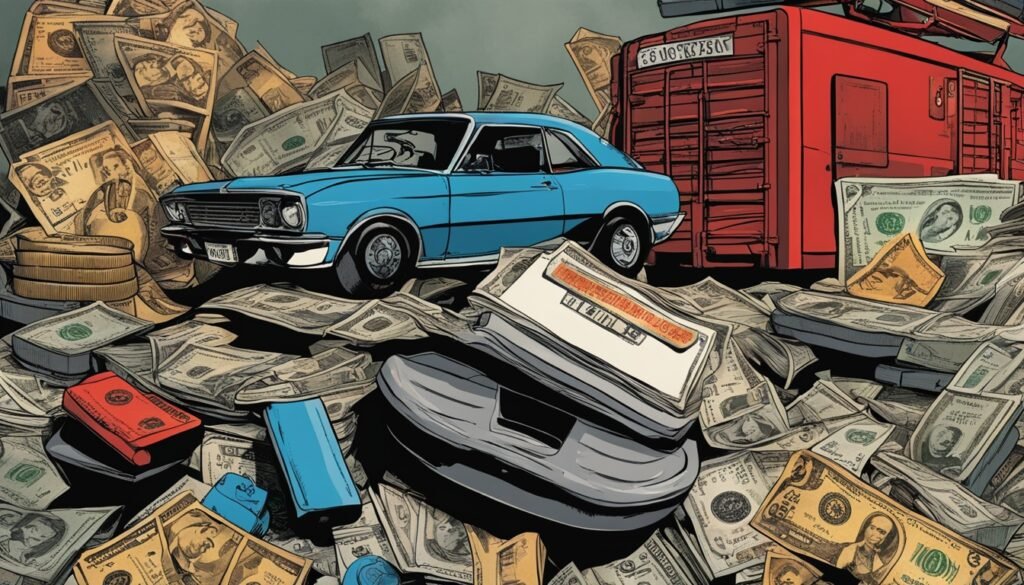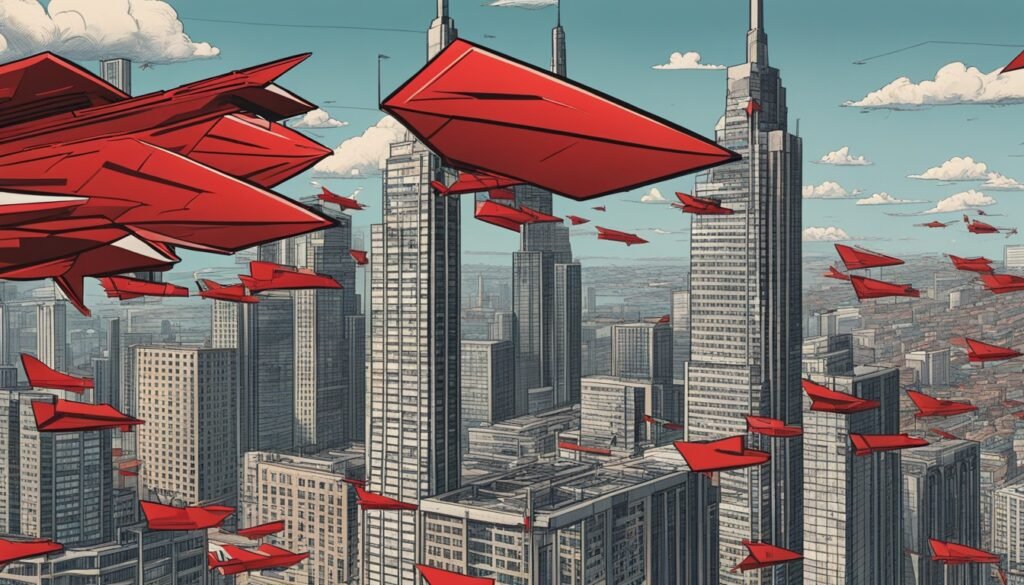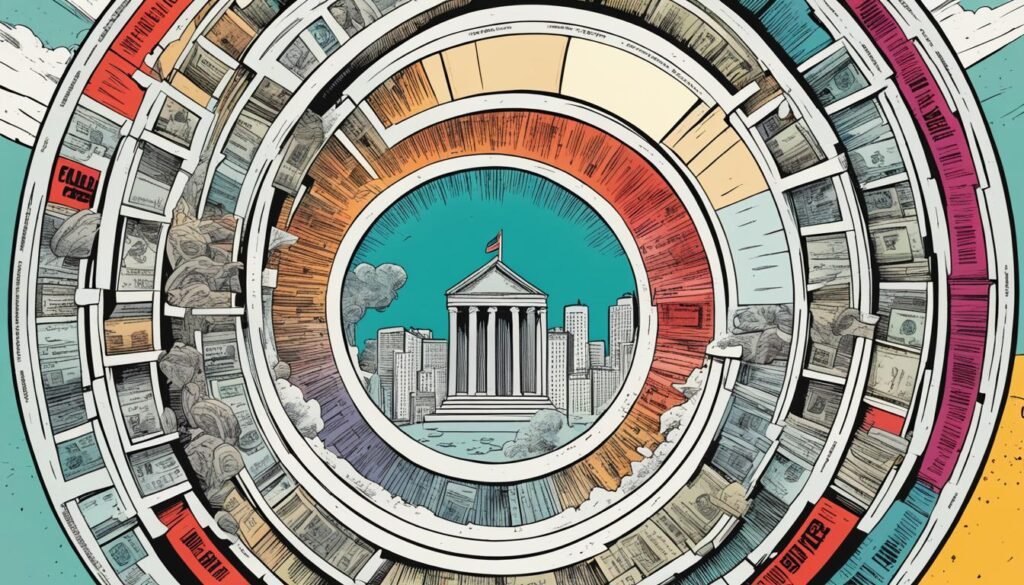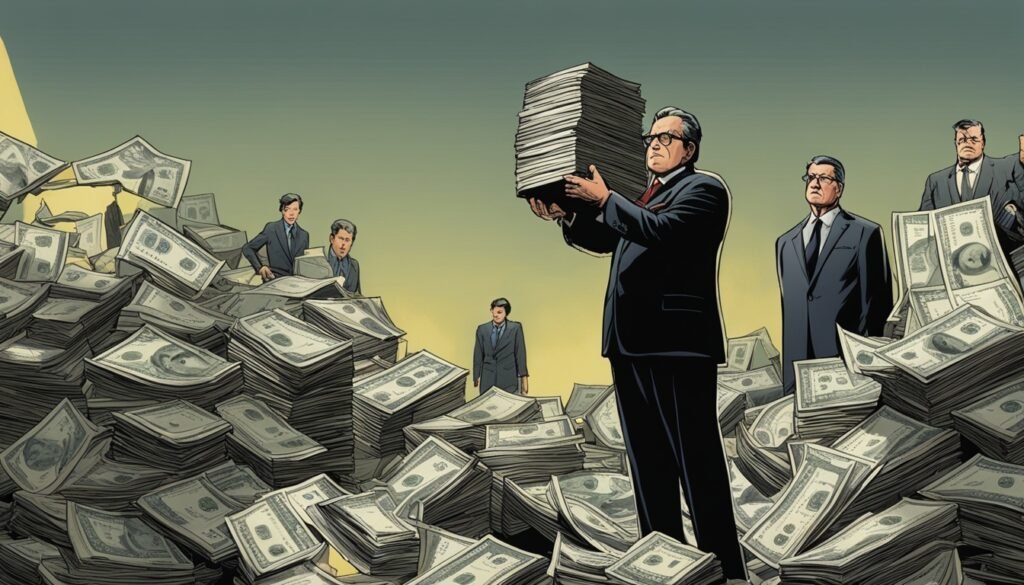The Philippines is still dealing with the debts from the Marcos era. These debts, created many years ago, are a big part of why the country struggles financially. They slow down economic growth and make life harder for today’s people.
In this article, we’ll look at how these debts began and grew. We’ll see how they’re linked to the country’s past recessions. Also, we’ll talk about global groups like the IMF and World Bank and their role in making the debt worse. Lastly, we’ll discuss ways for countries to deal with debts, especially in the Philippines.
Key Takeaways:
- Marcos era debts have had a lasting impact on the Philippines’ fiscal landscape.
- The accumulation of debt during the Marcos era correlated with economic recession.
- International institutions such as the IMF and World Bank played a significant role in escalating the country’s debt burden.
- Rising debt payments have had socio-economic consequences, leading to limited funding for essential sectors.
- Addressing and mitigating debt is crucial for sustainable development and poverty reduction in developing countries.
The Historical Context of Marcos Era Debts
When Ferdinand Marcos became the President in 1965, it started a time where the Philippines got into a lot of debt. It’s key to know why this debt built up during his time. This helps us understand the challenges the country faced.
The Emergence of Debt During Marcos’s Rule
In 1972, martial law was declared by Marcos. This led to even bigger economic problems because of political unrest. The Philippines turned to the United States and other Western countries for help because they were all against the Cold War.
The help came in the form of loans from different governments and global institutions like the World Bank. These loans were meant to improve the economy and make things more stable. But, they also added to the country’s debt, which is a problem for future generations.
“The assistance provided external assistance to the Marcos regime, but it also acted as a double-edged sword, contributing to the long-term consequences of debt.” – [Golden Era]
External Assistance and Its Double-edged Sword
Help from other countries was very important for the Philippines’ economy during Marcos’s time. These loans brought in money that helped with immediate problems and to make new infrastructure. But, at the same time, they made the country’s debt grow. This laid the foundation for big financial challenges ahead.
The World Bank and others wanted to help the economy grow. But the loans they gave also added to the growing debt of the Philippines. So, while the country benefited from the loans, it meant more debt to deal with later.
Explore the golden era of the Philippines and the historical significance of Marcos era debts.
Deciphering the Debt Explosion: 1970s to 1980s
From the 1970s to the 1980s, the Philippines saw a huge debt explosion. This had long-term effects on the economy. During the Marcos era, the government’s external debt went up from $600 million to over $6 billion. This was about 20% of GDP.
Economic policies and borrowing habits of the Marcos government caused this debt to grow. They depended heavily on loans to fund projects. This led to a quick growth in debt.
But, the debt was also influenced by global events. The early 1980s’ spike in US interest rates played a big role. As interest rates went up, so did the debt service cost. In just a couple of years, yearly debt payments more than doubled, adding more financial stress.
The effects of this debt boom were harsh. The country faced a recession in the mid-1980s, with GDP dropping by 20%. By 1987, the debt-to-GDP ratio was at 70%. This huge debt greatly slowed down economic growth and strained the government’s finances for years.
To understand the debt explosion and its Philippine impact better, check out this source.
Philippines’ Debt Explosion in the 1970s and 1980s
| Year | Government External Debt (in millions) | Debt-to-GDP Ratio |
|---|---|---|
| 1970 | $600 | – |
| 1980 | $6,000 | 20% |
| 1987 | – | 70% |
Correlation Between Debt and Economic Recession
During the Marcos era, the Philippines faced a big debt issue. This debt overload was hard to keep up with. It eventually caused the country’s growth to slow down and brought on a recession.
By the mid-1980s, the Philippines was in a terrible spot financially. Its GDP went down by over 20%. Meanwhile, the debt compared to the size of its economy was at an alarming 70%. This shows how having too much debt is really bad for a country’s economy.
Having a lot of debt can stop a country from growing in many ways. For one, it means the government must use a lot of its income to pay off the debt. This leaves less money for things like making the country better through public projects, education, and healthcare. So, the lack of investment can slow down a country’s progress and make life worse for its people.

Too much debt also scares off investors and makes borrowing money harder for the government. This makes the recession worse since there’s less money coming in from outside and from the private sector.
It is essential for governments to maintain a sustainable level of debt and implement effective debt management strategies to avoid the negative consequences of excessive borrowing.
Fighting the effects of too much debt needs a lot of different steps. Governments have to spend money wisely and on important things like education and healthcare. They should also look into ways to make their debt easier to handle, like getting some of it waived and seeking help from global financial groups.
By being smart about how they borrow and spend, countries can beat the downsides of too much debt. They can make a better, more stable economic future for themselves.
Learn more about the correlation between debt and economic recession.
IMF and World Bank Involvement with the Marcos Regime
The International Monetary Fund (IMF) and World Bank were key in the Philippines’ debt rise under Marcos. They gave huge loans, totaling $5.5 billion, during his time. This significantly increased the country’s debt.
The loans were supposed to help the country grow economically. But, they ended up leading to even more debt. So, while the IMF and World Bank helped with money, they also made the debt cycle worse.
The Role of International Institutions in Escalating Debt
The IMF and World Bank are big powers that can affect national economic policies. In the Philippines, their help led to a lot of debt during Marcos’s years. The loans were used for projects to help the economy but without clear plans for paying it back. This led to a growing debt problem for the country.
The Bataan Nuclear Power Plant stands as a clear example of the problems caused by IMF and World Bank loans. It was meant to produce electricity but was fraught with corruption and poor management. Despite huge expenses, it never generated power. The cost of building this plant contributes to the Philippines’ debt problems even today.
The Bataan Nuclear Power Plant Debacle
The Bataan Nuclear Power Plant was built to address the Philippines’ need for more energy. Yet, it faced corruption and safety issues from the start. It cost $2.3 billion, with most funds coming from loans. The high cost and lack of accountability made it a financial disaster. The plant was never used, reflecting corruption and inefficiency. The debt from its creation still burdens the Philippines today, affecting its ability to invest in important areas and services.
Callout Quote:
“IMF and World Bank loans provided short-term relief but created long-term burdens for the Philippines. The Bataan Nuclear Power Plant debacle serves as a stark reminder of the detrimental impact of excessive borrowing without proper oversight and accountability.”
| Loan Details | Amount (USD) | Source |
|---|---|---|
| IMF Loans | 4.5 billion | IMF |
| World Bank Loans | 1 billion | World Bank |
| US Loans for Bataan Nuclear Power Plant | 400 million | US Government |
| Total Loans | 5.9 billion | Various sources |
The Socio-economic Impact of Rising Debt Payments
The Marco era’s rising debt payments greatly affected the Philippines. A lot of the government’s money was going to pay off debt. This left less for important areas like health and education. Giving more priority to debt payments made inequality worse. It also slowed down social programs.
This problem showed how too much debt for a country can hurt its progress and the people living there. The Philippines struggled to fight poverty, improve services, and grow its economy. It was hard to do this when much money had to go towards debt.
“Effective governance requires fiscal discipline, and the burden imposed by rising debt payments impeded the Philippines’ ability to allocate sufficient resources to key socio-economic areas.”
This made a never-ending poverty cycle. Not having enough money for education, health, and building things like roads made things worse. The gap between richer and poorer parts of the country grew bigger.
To solve the issue, the Philippines is trying to reduce its debt and develop sustainably. They want to balance paying off debt with investing in important areas. This includes fighting poverty, improving living conditions, and helping the economy grow evenly.
One good plan is to manage money better and find new ways to make money. This includes spending public money in smarter ways. Less debt means more money for things that really matter to people’s lives.

Also, being clear about where the money comes and goes helps stop corruption. This way, money is used properly to help Filipinos. Good financial rules and holding government officials accountable can lessen the impact of debt.
The World Bank and others stress the need for the Philippines to handle debt smartly. Doing this helps them get help when needed without risking their future. Everyone wants a stable, growing economy in the long run.
By dealing with the impact of high debt, the Philippines can aim for a better future. This effort requires careful money management and big changes. Putting the economy and the people first is key.
“Addressing the socio-economic impact of rising debt payments is pivotal for achieving inclusive growth, reducing inequality, and building a stronger future for the Philippines.”
| Social Sector | Impact of Rising Debt Payments |
|---|---|
| Education | Insufficient resources for quality education and training programs, limited access to educational opportunities, hindering human capital development. |
| Healthcare | Inadequate funding for healthcare services, limited access to quality healthcare, hindering public health outcomes and well-being. |
| Infrastructure | Reduced investments in critical infrastructure projects, hindering transportation networks, urban development, and economic productivity. |
| Poverty Alleviation | Inadequate funding for social welfare programs, hindering poverty alleviation efforts and exacerbating socio-economic disparities. |
The Department of Finance of the Philippines stresses the importance of managing money better. They say this is crucial for bouncing back from COVID-19 and lessening the impact of debt. Their goal is to make reforms and have a stable financial plan.
Non-legitimization and Cancellation Demands of Activists
During the Marcos era, Philippine activists fought hard against huge debts. They saw how these loans hurt their country’s economy. These activists wanted the government to cancel the debts and be held responsible for its actions. Their push for change grew stronger during the Edsa Revolution in 1986. This was a big moment in their fight against bad debts.
The Edsa Revolution was a set of peaceful protests in Manila. It led to President Ferdinand Marcos being taken down. People, including activists, were tired of his strict rule and bad financial choices. This event showed that the power to make things better was in the hands of the Filipino people.
But, even with demands for debt to be cancelled, President Corazon Aquino didn’t agree. She said the country owed the money and had to pay it. Aquino thought not paying off this debt would damage the Philippines’ reputation around the world. Even though activists were upset, Aquino’s choice showed her focus was on keeping the country’s money matters in check.
Formation and Role of the Freedom from Debt Coalition
In 1987, after the Marcos era, the Freedom from Debt Coalition started. It aimed to make the debts clearer and to push for changes in debt payments. This way, they hoped to boost economic growth and lower poverty.
The coalition was key in telling people about the debt problem and in pushing for changes. They teamed up with the Jubilee South Movement. This group works worldwide to fight unfair debts.
The Freedom from Debt Coalition knew talking about debt issues was important. They wanted to show where the debt came from and who was affected. They made sure those in charge took responsibility and shared what they found with everyone. This helped the public understand better.
This group didn’t just act in the Philippines. They joined efforts with the Jubilee South Movement across the globe. Together, they worked for debt relief and new plans for development. They aimed to make the world’s economic system fairer and better for everyone.
Learn more about the impact of debt on the Philippines
The Perpetual Cycle of High Debt Payments
The Philippines has tried hard to lower its debt. But, it’s still trapped in a cycle of making big debt payments. This has been happening since the 1980s to the 2000s, taking out a lot of money from what the country earns.
During the 80s and 90s, about 17% of the money from selling goods went to debt payments. Even in the 2000s, this number was still at 12%. This constant high debt payment has stopped the country from putting enough money into things like education and health.

The money going to debts could’ve been used for making the country better. It could support building roads, health care, and schools. But, instead, it’s stuck in this loop, not letting the country grow economically.
The key to breaking this cycle is to manage debts better. This means reducing how much is owed compared to what the country makes, finding better ways to pay back the debt, and growing the economy in new, sustainable ways. It’s important for the government to spend on areas that will help the country earn more in the future.
By effectively managing its debt burden and adopting prudent fiscal policies, the Philippines can gradually reduce its reliance on debt and create a more sustainable financial future.
It’s also essential for the government to look for new economic opportunities. Encouraging foreign businesses to invest can bring in more money. This will help spend less on debts and more on building a stronger, healthier country.
High debt keeps the Philippines from reaching its full potential. It needs to find a way out of this cycle. Only then can it plan for a future where everyone has a chance to succeed.
For more information on the impact of high debt payments and strategies for managing debt in developing countries, refer to this resource.
Debt’s Role in Poverty and Stunted Economic Growth
Debt has greatly impacted poverty and economic growth in the Philippines. The debt problem makes it hard for the country to fight poverty and grow steadily. This part will show how debt has made poverty worse in the Philippines compared to some East Asian places.
Comparative Poverty Trends in East Asia and the Philippines
The Philippines is falling behind its East Asian neighbors in poverty reduction. While many nations around the region have cut down poverty, the Philippines has seen more people fall into it. Debt’s negative effects on reducing poverty are clear in this comparison.
The Irony of Economic Growth Amidst Inflating Poverty Rates
In the Philippines, economic growth and rising poverty rates are happening together. The country finds it tough to battle poverty because of its heavy debts. This situation shows the urgency of managing debt in ways that help the poor and promote growth at the same time.
Modern Ramifications of Debt on Government Spending
The past debts from Marcos’s time still affect the Philippines today. The big debt means the government has to use a lot of money to pay it. This leaves less money for important things like health, education, and roads.
This document looks at how debt affects spending now. It talks about the hard choices the government has to make. Like, managing debt but still spending on necessary public services.
The growing debt makes it hard for the government to spend on health, education, and things like new roads. This lack of spending affects the country’s development and the people’s lives deeply.
High debt today means less money for helping the economy and the people. A lot of the budget goes to paying off debt. This leaves very little for important areas like health and education.
Below is a table showing how much the Philippines spends in different areas:
| Government Spending Allocation | Percentage of Budget |
|---|---|
| Debt Servicing | 40% |
| Education | 20% |
| Public Health | 15% |
| Infrastructure | 10% |
| Other Essential Sectors | 15% |
This table shows that spending on debt is a big part of the budget. There’s not much left for things like education and health. These are crucial for helping the country grow and its people thrive.
To deal with debt’s effects on spending, we need many solutions. This includes better debt handling, finding more ways to make money, being clear about finances, and using smart budgeting.

By handling debt smartly and focusing on the people, the Philippines can move towards fair and lasting growth.
Controversial Projects and the Legacy of Excessive Loans
In the time of Marcos, the government took on too many loans to fund different projects. An example is building ‘Bridges to Nowhere’. These bridges were built in places without much traffic or economic worth. Such projects are now seen as a waste of money and have deep corruption issues. This has left the country struggling with a lot of debt.
Looking back at these investments helps us understand the debt from the Marcos era. It’s important to see how these projects affected the country. We must take these lessons to heart to make sure we’re more open and honest in our future work.
The legacy of too many loans and bad projects shows us the importance of good money management. We should avoid corruption at all costs. By not repeating past mistakes, the Philippines can move towards a better and richer tomorrow.
International Aid and the Philippine Debt Trajectory
The Philippine debt has been greatly affected by aid from other countries. During the Marcos era, the Philippines got big loans from many places. This borrowing and paying back money has changed how the country’s finances look.

We will look at how international aid has influenced the Philippines’ debt path. We’ll talk about the conditions of these help packages, how lenders made the debt worse, and the hard work needed to handle and reduce debt in a developing nation.
Debt
An Overview of the Philippines’ Current Debt Status
In the Philippines, the current debt status raises concerns. As of [current year], the country’s debt is at [total debt amount]. This debt’s size is measured as the debt-to-GDP ratio. It shows how well the country can handle and pay back its debts. The current debt-to-GDP ratio is at [debt-to-GDP ratio], showing a heavy debt load.
Payments for debt services, including interest and repayments, strain the budget significantly. These payments take up a large part of the government’s budget. This leaves less money for important sectors like healthcare, education, and building infrastructure.
Strategies for Mitigating Debt in Developing Countries
The Philippines is learning valuable lessons on managing debt. One way to ease the burden is through debt restructuring. This involves renegotiating loan terms, extending payback times, or cutting interest rates. Debt relief programs, like those offered by international bodies, can also help by reducing or eliminating some debt.
For lasting solutions, countries need to reform their economies and financial practices. They should aim to earn more money internally and lessen the need for loans. This can be done by boosting local industries, attracting foreign investments, and improving tax systems.
Good financial habits, transparency, and accountability are key to keeping debt at a manageable level. Governments must be careful about borrowing, check the effects of new projects before getting loans, and use borrowed money wisely and efficiently.
By following these steps and managing debt smartly, countries like the Philippines can overcome high debt challenges. This helps them secure long-term economic stability and growth.
Conclusion
In the aftermath of the Marcos era, the Philippines faces a heavy debt burden. These debts stemmed from Ferdinand Marcos’s term, impacting the country’s finances severely. The historical context, ties to economic downturns, and roles of global financial bodies all shape these debts’ influence.
The debts have significantly slowed down economic progress. They restrict the government from investing more in vital areas like health and education. This leads to higher poverty and fewer social services. The IMF and World Bank, through controversial projects, also share the blame for the debt crisis.
Moving forward, the Philippines and similar nations must find ways to handle their debts better. They need to focus on growing their economy and fighting poverty. This calls for better debt management, fiscal changes, and more openness in finance. Such steps will ease debt stress and help create brighter lives for the people.
FAQ
What is the historical context of Marcos era debts?
In 1965, the Marcos era began in the Philippines. Debt started becoming a big issue then. Marcos declared martial law in 1972. This move got a lot of help from the US and Western countries, which added to the country’s debt.
How did debt explode during the 1970s to 1980s?
Between 1970 and 1980, the country’s external debt shot up. It went from 0 million to over billion. That was about 20% of the GDP. This debt growth was due to Marcos’s financial policies and how much money the country borrowed.
The US raising interest rates in the early 1980s made things worse.
What was the correlation between debt and economic recession during the Marcos era?
By the mid-1980s, the debt was too big to handle. The economy slowed down and a recession hit. By 1987, the debt was 70% of the GDP.
The GDP also shrank by more than 20%.
What role did the IMF and World Bank play in Marcos era debts?
The IMF and World Bank gave the Philippines a big debt of .5 billion. This money was supposed to help the country grow economically. But, it just added to the debt.
A big project that foreign loans funded was the corrupt Bataan Nuclear Power Plant.
What was the socio-economic impact of rising debt payments?
As the country paid more and more debt, there was less money for things like health and education. This made inequality worse and hurt social programs.
What was the response to demands for non-legitimization and cancellation of debts?
In 1986, during the Edsa Revolution, activists asked for the debt to be canceled. President Aquino after Marcos chose to pay back all the debt first, instead of spending on other needs.
What was the role of the Freedom from Debt Coalition?
The Freedom from Debt Coalition started in 1987. They wanted to get rid of the debt and make the debt issue more transparent. They joined the global fight against heavy debt.
Why has the Philippines been stuck in a perpetual cycle of high debt payments?
The country used a lot of money to pay back its debt from what it earned from exports. This made it hard to spend on other things. From the 1980s to the 1990s, 17% of what the country earned from exports went to debt payments.
How has debt impacted poverty and economic growth in the Philippines?
Looking at poverty in East Asia, the Philippines stands out. Unlike its neighbors that have less poverty, poverty in the Philippines has gone up.
What is the legacy of excessive loans during the Marcos era?
Too many loans meant funding bad projects and a lot of corruption. Wasteful projects, like the ‘Bridges to Nowhere,’ show this.
What is the impact of international aid on the Philippine debt trajectory?
International aid, from loans and other forms, has deeply affected the country’s financial situation.
What is the current debt status of the Philippines?
In this section, we will look at the Philippines’ debt amount, its relationship with the GDP, and how it’s dealing with debt. We’ll also check out ways to lower debt for developing countries.

